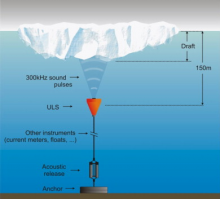If you would like to see more information on this case study, click here!
You can request this case study and a WCDE staff member will get back to you.
 Sea ice poses a substantial treat to any vessel attempting to navigate the waters around the Canadian Arctic, and renders the region virtually inaccessible to the plethora of shipping companies and nations looking to establish a more direct transport route through the northwest. Prior to developing an effective trade route, it is critical to procure information on the state and thickness of the ice. Currently, sea ice charts and climatologies are produced by the Canadian Ice Service (CIS), the U.S. National Ice Centre (NIC), and other organizations with a similar mission. These charts are generated manually by assimilating data from multiple sensors such as remote synthetic aperture radars (SARs) and moored Upward-Looking Sonars. There is inconsistency in the quality of analyses derived from these methods, largely because data is amalgamated from a large variety of sources and image analyses conducted by ice operators are highly subjective. Therefore, an automated algorithm that can generate regional ice charts with accuracy comparable to or greater than their manually produced counterparts is highly sought-after. Dr. Katherine Andrea Scott, assistant professor at the University of Waterloo in the Systems Design Engineering Department, is working with an efficient model which calculates sea ice thickness on the Canadian East Coast. The calculated ice thickness can be combined with other data in an automatic data assimilation algorithm.
Sea ice poses a substantial treat to any vessel attempting to navigate the waters around the Canadian Arctic, and renders the region virtually inaccessible to the plethora of shipping companies and nations looking to establish a more direct transport route through the northwest. Prior to developing an effective trade route, it is critical to procure information on the state and thickness of the ice. Currently, sea ice charts and climatologies are produced by the Canadian Ice Service (CIS), the U.S. National Ice Centre (NIC), and other organizations with a similar mission. These charts are generated manually by assimilating data from multiple sensors such as remote synthetic aperture radars (SARs) and moored Upward-Looking Sonars. There is inconsistency in the quality of analyses derived from these methods, largely because data is amalgamated from a large variety of sources and image analyses conducted by ice operators are highly subjective. Therefore, an automated algorithm that can generate regional ice charts with accuracy comparable to or greater than their manually produced counterparts is highly sought-after. Dr. Katherine Andrea Scott, assistant professor at the University of Waterloo in the Systems Design Engineering Department, is working with an efficient model which calculates sea ice thickness on the Canadian East Coast. The calculated ice thickness can be combined with other data in an automatic data assimilation algorithm.
Kevin Pauley, a 3A Mechanical Engineering coop student from the University of Waterloo, worked with Dr. Scott investigating an algorithm that computed the East Coast of Canada sea ice thickness using optical satellite data acquired from the Moderate Resolution Imaging Spectroradiometer (MODIS) sensor aboard the National Aeronautics and Space Administration’s Aqua satellite for the month of January, 2007.
This case can be used in courses that cover topics in one dimensional heat transfer. The solution modules present heat balance which is solved iteratively, using the Newton-Raphson method and the bisection method. The case can provide effective material for the Heat Transfer 1 (ME 353), Thermodynamics (SYDE 381), Transport Process Analysis (CHE 322), and other similar heat transfer courses. Upon completion of the case study, the intended learning outcomes include:
If you would like to see more information on this case study, click here!
You can request this case study and a WCDE staff member will get back to you.
Contact Waterloo Cases in Design Engineering
Steve Lambert
Tel: (519) 888-4728
Email: steve@uwaterloo.ca
The University of Waterloo acknowledges that much of our work takes place on the traditional territory of the Neutral, Anishinaabeg and Haudenosaunee peoples. Our main campus is situated on the Haldimand Tract, the land granted to the Six Nations that includes six miles on each side of the Grand River. Our active work toward reconciliation takes place across our campuses through research, learning, teaching, and community building, and is co-ordinated within the Office of Indigenous Relations.